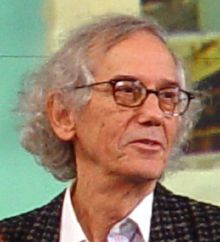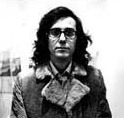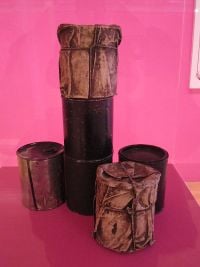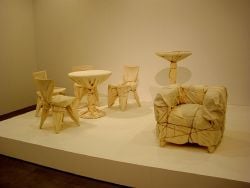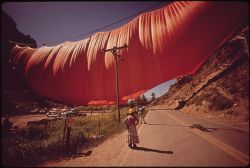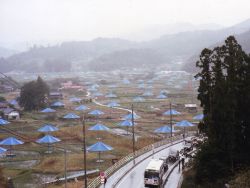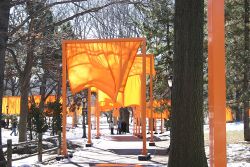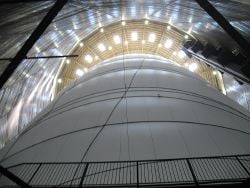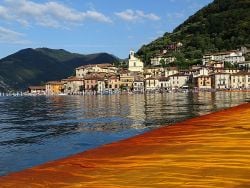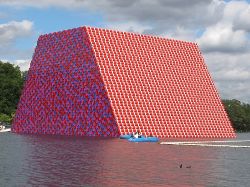Christo and Jeanne-Claude
| Christo and Jeanne-Claude | |
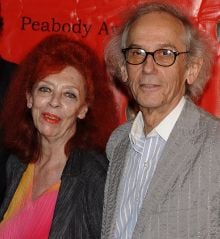 Jeanne-Claude and Christo in May 2009 | |
| Field | Environmental art |
| Movement | Nouveau réalisme Environmental art |
| Awards | Praemium Imperiale |
Christo Vladimirov Javacheff (June 13, 1935 â May 31, 2020) and Jeanne-Claude Denat de Guillebon (June 13, 1935 â November 18, 2009), known as Christo and Jeanne-Claude, were artists noted for their large-scale, site-specific environmental installations, often large landmarks and landscape elements wrapped in fabric, including the Wrapped Reichstag, The Pont Neuf Wrapped, Running Fence in California, and The Gates in New York City's Central Park.
Born on the same day in Bulgaria and Morocco, respectively, the pair met and married in Paris in the late 1950s. Originally working under Christo's name, they later credited their installations to both "Christo and Jeanne-Claude." Until his own death in 2020, Christo continued to plan and execute projects after Jeanne-Claude's death in 2009.
Their work was typically large, visually impressive, and controversial, often taking years and sometimes decades of careful preparation â including technical solutions, political negotiation, permitting and environmental approval, hearings, and public persuasion. The pair refused grants, scholarships, donations, or public money, instead financing the work via the sale of their own artwork. While the installations of their projects were temporary, their impact on not only the art world but the general public remains a treasured legacy of beauty and joy.
Biographies
Christo
Christo Vladimirov Javacheff (Bulgarian: Đ„ŃĐžŃŃĐŸ ĐĐ»Đ°ĐŽĐžĐŒĐžŃĐŸĐČ ĐŻĐČĐ°ŃĐ”ĐČ) was born on June 13, 1935, in Gabrovo, Bulgaria, as the second of three sons to Tzveta Dimitrova and Vladimir Javacheff, who worked at a textile manufacturer.[1] Christo was shy and had a predilection for art. He received private art instruction at a young age through the support of his parents, who invited visiting artists to their house.
Christo was particularly affected by events from World War II and his country's fluid borders. During evacuations, he and his brothers stayed with a family in the rural hills outside town, where Christo connected with nature and handicraft.
While Bulgaria was under repressive totalitarian rule, and Western art was suppressed, Christo pursued realistic painting through the mid-1950s. He was admitted into the Sofia Academy of Fine Arts in 1953, but found the school dull and stifling. Instead, he found inspiration in Skira art books, and visiting Russian professors who had been active in Russian modernism and the Soviet avant-garde. On the weekends, academy students were sent to paint propaganda and Christo unhappily participated.[1]
He found work as a location scout for the state cinema and served three tours of duty during summer breaks. In 1956, he used an academy connection to receive permission to visit family in Prague, where the theater of Emil FrantiĆĄek Burian reinvigorated him. Amid fears of further Russian suppression in Hungary, Christo decided to flee to Vienna as a railcar stowaway. He had little money after paying the bribe, did not speak the language, had deserted during his Bulgarian military service, and feared being trapped in a refugee camp.[1]
In Vienna, he stayed with a family friend (who had not expected him), studied at the Vienna Fine Arts Academy, and surrendered his passport to seek political asylum as a stateless person. There, he supported himself with commissions and briefly visited Italy with the academy, whose program he was equally unhappy with. At the behest of a friend relocated from Sofia, he saved up to visit Geneva in late 1957. In violation of his visa, he continued to pursue commissions (whose works he would sign with his family name, reserving his given name for more serious work) and was transformed after visiting the Kunstmuseum Basel and Kunsthaus ZĂŒrich. In January 1958, he first began to wrap items, starting with a paint can. In February 1958, Christo left for Paris, having received a visa with the assistance of a Sofia academy connection.[1]
In 1973, after 17 stateless years, Christo became a United States citizen.[2] He died at his home in New York City on May 31, 2020, at 84.[3]
Jeanne-Claude
| Jeanne-Claude | |
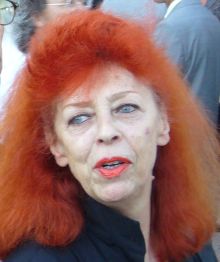 | |
| Birth name | Jeanne-Claude Denat de Guillebon |
| Born | June 13 1935 Casablanca, French Morocco |
| Died | November 18 2009 (aged 74) New York City, New York, U.S. |
| Training | Selfâtaught |
Jeanne-Claude Denat de Guillebon (French pronunciation: [Êan klod dÉna dÉ gijÉbÉÌ]) was born in Casablanca, Morocco, where her father, an army officer, was stationed. Her mother, PrĂ©cilda, was 17 when she married Jeanne-Claude's father, Major LĂ©on Denat. PrĂ©cilda and LĂ©on Denat divorced shortly after Jeanne-Claude was born, and PrĂ©cilda remarried three times. Jeanne-Claude earned a baccalaurĂ©at in Latin and philosophy in 1952 from the University of Tunis. After PrĂ©cilda married General Jacques de Guillebon in 1947, the family lived in Bern (1948â1951) and Tunisia (1952â1957) before returning to Paris.[1]
Jeanne-Claude was described as "extroverted" and with natural organizational abilities. Her hair was dyed red, which she claimed was selected by her husband.[4] She became an American citizen in March 1984.[1]
Jeanne-Claude died in New York City on November 18, 2009, from complications due to a brain aneurysm. Her body was to be donated to science, in accordance with her wishes.[5] When she died, she and Christo were at work on Over the River and the United Arab Emirates project, The Mastaba.[6] She said, "Artists don't retire. They die. That's all. When they stop being able to create art, they die."[7]
Marriage
Christo and Jeanne-Claude met in October 1958 when he was commissioned to paint a portrait of her mother, Précilda de Guillebon. At the time Jeanne-Claude was engaged to Philippe Planchon.[1] Initially, Christo was attracted to Jeanne-Claude's half-sister, Joyce. Although she married Planchon, Jeanne-Claude left him for Christo immediately after their honeymoon. Christo and Jeanne-Claude's son, Cyril, was born on May 11, 1960.[8]
Work
Christo and Jeanne-Claude developed consistent, longtime terms of their collaboration. Together they imagined projects, for which Christo would create sketches and preparatory works that were later sold to fund the resulting installation. Assistants were hired to do the work of installing the artwork. Jeanne-Claude took responsibility for overseeing work crews and for raising funds.[9]
They originally worked under the name "Christo" to simplify dealings and their brand, given the difficulties of establishing an artist's reputation and the prejudices against female artists,[10] but they would later retroactively credit their large-scale outdoor works to both "Christo and Jeanne-Claude." They eventually flew in separate planes such that, in case one crashed, the other could continue their work.[9]
Although many have referred to Christo and Jeanne-Claude's work primarily as "wrapping," this is only one method they used to achieve their purpose. Their work was about altering an environment so that objects could take on a new identity. Wrapping them is one way to achieve this, as it reveals the features and proportions of an object while hiding the more intricate details. An important aspect of their work was to impart a temporary, light, fragile character to even solid stone objects, or simply to create structures with a nomadic impression, which they did with the use of fabric.[11]
Their creations were temporary, and all evidence of the installation was removed after the final day of exhibition. Christo explained that artists have put many qualities into their art, but not the quality of love for the temporary:
But there is one quality they have never used, and that is the quality of love and tenderness that human beings have for what does not last. For instance, they have love and tenderness for childhood because they know it will not last. They have love and tenderness for their own life because they know it will not last. Christo and Jeanne-Claude wish to donate this quality of love and tenderness to their work, as an additional aesthetic quality. The fact that the work does not remain creates an urgency to see it. For instance, if someone were to say, "Oh, look on the right, there is a rainbow," one would never answer, "I will look at it tomorrow."[12]
1960s
Their first show, in Cologne, 1961, showcased the three types of artworks for which they would be known: wrapped items, oil barrels, and ephemeral, large-scale works. Near Christo's first solo show in Paris, in 1962, the pair blocked an alley with 240 barrels for several hours in a piece called Iron Curtain, a poetic reply to the Berlin Wall.[13]
The couple relocated to New York City, the new art world capital, in 1964. Christo began to make Store Fronts, wooden facades made to resemble shop windows, which he continued for four years. His largest piece was shown in the 1968 Documenta 4. In the mid-1960s, they also created Air Packages, inflated and wrapped research balloons.[14] In 1969, they wrapped the Chicago Museum of Contemporary Art while it remained open. It was panned by the public and ordered to be undone by the fire department, which went unenforced.[14] With the help of Australian collector John Kaldor, Christo and Jeanne-Claude and 100 volunteers wrapped the coast of Sydney's Little Bay as Wrapped Coast, the first piece for Kaldor Public Art Projects.[15]
1970s
They formed a corporation to benefit from tax and other liabilities, a form they used for later projects.
Within a year of completing Wrapped Coast, Christo began work on Valley Curtain, an orange curtain of fabric to be hung across the mountainous Colorado State Highway 325.[13] They simultaneously worked on designs for Wrapped Walk Ways (Tokyo and Holland) and Wrapped Island (South Pacific), neither of which came to fruition.
Following a failed attempt to mount the curtain in late 1971, a new engineer and builder-contractor raised the fabric in August 1972. The work only stood for 28 hours before the wind again destroyed the fabric. This work, their most expensive to date and the first to involve construction workers, was captured in a documentary, Christo's Valley Curtain by David and Albert Maysles.[13] The film was nominated for Best Documentary Short in the 1974 Academy Awards.[16] The Maysles also filmed many of the artists' later projects.
Inspired by a snow fence, in 1972, Christo and Jeanne-Claude began preparations for Running Fence: a 24.5-mile fence of white nylon, supported by steel posts and steel cables, running through the Californian landscape and into the ocean. In exchange for temporary use of ranch land, the artists agreed to offer payment and use of the deconstructed building materials. Others challenged its construction in 18 public hearings and three state court sessions. The fence began construction in April 1976 and the project culminated in a two-week display in September, after which it was deconstructed.[17]
In 1978, their Wrapped Walk Ways covered 2.7 miles (4.4 kilometers) of paths within Kansas City, Missouri's Loose Park in fabric.[18]
1980s
Surrounded Islands was based on Jeanne-Claude's idea to surround eleven islands in Miami's Biscayne Bay with 603,850 square meters (6,499,800 sq ft) of pink polypropylene floating fabric. The project involved the aid of 430 workers who were outfitted with pink long sleeve shirts with pale blue text written on the back reading âChristo Surrounded Islands,â and then in acknowledging the garment's designer, "designed and produced by Willi Smith."[19] The project was completed on May 7, 1983 and remained on show for two weeks.
In 1985, the couple received permission to wrap the Pont Neuf, a bridge in Paris. The Pont Neuf Wrapped attracted three million visitors during its two weeks on show.[13] Wrapping the Pont Neuf in fabric maintained the principal shapes of the Pont Neuf and emphasized the proportions, while covering the details of the stonework. As with Surrounded Islands, workers who assisted with the installation and de-installation of Pont Neuf Wrapped wore uniforms designed by Willi Smith.[19]
1990s
Their 1991 The Umbrellas involved the simultaneous setup of blue and gold umbrellas in Japan and California, respectively. The 3,100-umbrella project cost US$26Â million and attracted three million visitors.[13] Christo closed the exhibition early after a woman was killed by a windblown umbrella in California.[20] Also, a worker was killed during the deconstruction of the Japanese exhibit.[21]
In 1995, Christo and Jeanne-Claude wrapped the Berlin Reichstag building following 24 years of governmental lobbying across six Bundestag presidents. Wrapped Reichstag's 100,000 square meters of silver fabric draped the building, fastened with blue rope.[22] Christo described the Reichstag wrapping as autobiographical, based on his Bulgarian upbringing. He said that even though he was not German, coming from an Eastern European country he was very concerned about East-West relations: "I believe they are the paramount issues in 20th Century life."[23] The wrapping became symbolic of re-unified Germany, and marked Berlin's return as a world city.[24] This work was described as their "most spectacular achievement."[25]
In 1998, the artists wrapped trees at the Beyeler Foundation and its nearby Berower Park. Prior attempts had failed to secure government support in Saint Louis, Missouri, and Paris. The work was self-funded through sale of photographic documentation and preparatory works, as had become standard for the couple.[26]
Over the River
Christo and Jeanne-Claude's inspiration for Over the River came in 1985 as they were wrapping the Pont-Neuf and a fabric panel was being elevated over the Seine. The artists began a three-year search for appropriate locations in 1992, considering some eighty-nine river locations.[27] They chose the Arkansas River because its banks were high enough that recreational rafters could enjoy the river at the same time.
Christo and Jeanne-Claude spent more than $6Â million on environmental studies, design engineering, and wind tunnel testing of fabrics. As with past projects, Over The River would be financed entirely by Christo and Jeanne-Claude, through the sale of Christo's preparatory drawings, collages, scale models, and early works of the 1950s/1960s.
Over The River was to be constructed on the Arkansas River between Salida, Colorado, and Cañon City, Colorado, on the eastern slope of the Rocky mountains. Plans for the project call for horizontally suspending 6.7 miles (10.8 km) of reflective, translucent fabric panels high above the water, on steel cables anchored into the river's banks. It was to be installed for two weeks during the summer of 2015, at the earliest, and for the river to remain open to recreation during the installation.
On July 16, 2010, the U.S. Bureau of Land Management released its four-volume Draft Environmental Impact Statement, which reported many potentially serious types of adverse impact but also many proposed "mitigation" options.[28]
Reaction among area residents was intense, with supporters hoping for a tourist boom and opponents fearing that the project would ruin the visual appeal of the landscape and inflict damage on the river ecosystem. One local rafting guide complained: "Hanging rags over the river is the same as hanging pornography in a church."[29] The U.S. Bureau of Land Management released a Record of Decision approving the project on November 7, 2011. However, before the Notice to Proceed was issued, a lawsuit against the Colorado Division of Parks and Wildlife was filed on July 22, 2011, by Rags Over the Arkansas River (ROAR), a local group opposed to the project.[30]
In January 2017, after five years of legal arguments, Christo canceled the controversial project, deciding to devote his energy, time, and resources into the realization of other projects.
The Gates
Work began on the installation of the couple's most protracted project, The Gates, in New York City's Central Park in January 2005. Its full title, The Gates, Central Park, New York, 1979â2005, refers to the time that passed from their initial proposal until they were able to go ahead with it with the permission of the new mayor Michael R. Bloomberg.[31] The Gates was open to the public from February 12â27, 2005. A total of 7,503 gates made of saffron-colored fabric were placed on paths in Central Park. They were 5Â meters (16Â ft) high and had a combined length of 37Â kilometers (23Â mi). The project cost an estimated US$21Â million, which the artists planned to recoup by selling project documentation.[32]
Big Air Package
The Big Air Package for Gasometer Oberhausen, Germany was conceived by Christo in 2010; the first project without his wife Jeanne-Claude. After The Wall (1999) as the final installation of the Emscher Park International Building Exhibition, Big Air Package was his second work of art in the Gasometer.
Christo filled the Gasometer Oberhausen from March 16 until December 30, 2013 with the installation. The sculpture was set up in the interior of the industrial monument and was made of 20,350 cubic meters (719,000 cu ft) of translucent fabric and 4,500 meters (15,000 ft) of rope. In the inflated state, the envelope, with a weight of 5.3 tonnes (5.8 short tons), reached a height of more than 90 meters (300 ft), a diameter of 50 meters (160 ft) and a volume of 177,000 cubic meters (6,300,000 cu ft). The monumental work of art was, temporarily, the largest self-supporting sculpture in the world. In the accessible interior of Big Air Package was a unique experience of space, proportions, and light.[33]
The Floating Piers
The Floating Piers were a series of walkways installed at Lake Iseo near Brescia, Italy. From June 18 to July 3, 2016, visitors were able to walk just above the surface of the water from the village of Sulzano on the mainland to the islands of Monte Isola and San Paolo. The floating walkways were made of 220,000 polyethylene cubes covered with 70,000 square meters (750,000 sq ft) of bright yellow fabric: 3 kilometers (1.9 mi) of piers moved on the water; another 1.5 kilometers (0.93 mi) of golden fabric continued along the pedestrian streets in Sulzano and Peschiera Maraglio. The installation was facilitated by the Beretta family, owners of the oldest active manufacturer of firearm components in the world, who own the island of San Paolo, which was surrounded by Floating Piers walkways.[34] After the exhibition, all components were removed and recycled.[35]
The work was a success with the Italian public and critics alike.[36]
The London Mastaba
The London Mastaba was a temporary floating installation exhibited from June to September 2018 on The Serpentine lake in London. The installation consisted of 7,506 oil barrels, in the shape of a mastaba, a form of early tomb used in ancient Mesopotamia, with a flat roof and inward sloping sides. The installation sat on a floating platform of high-density polyethylene, held in place by 32 anchors. It was 20Â meters (66Â ft) in height and weighed 600 tonnes (660 short tons). The vertical ends were painted in a mosaic of red, blue, and mauve, whilst the sloping sides were in red with bands of white.[37]
Simultaneously with the display of The London Mastaba, the nearby Serpentine Gallery presented an exhibition of the artists' work, entitled Christo and Jeanne-Claude: Barrels and The Mastaba 1958â2018. The exhibition comprised sculptures, drawings, collages, scale-models, and photographs from 60 years of the artists' work.[38]
Posthumous projects
The Mastaba in Abu Dhabi
Another Mastaba of over 400,000 oil barrels rising nearly 500 feet in the air is intended to be built at Al Gharbia, 100Â miles (160Â km) from the city Abu Dhabi. The project was first conceived in 1977, and after a protracted planning process and various delays, the site at Al Gharbia was approved for the installation.[39]
The colors and the positioning of the barrels were selected by Christo and Jeanne-Claude in 1979, the year of their first visit to the Emirate. This Mastaba was planned as Christo and Jeanne-Claudeâs only permanent large-scale work.[40]
L'Arc de Triomphe, Wrapped
Continuing their series of monumental "wrapping" projects, the Arc de Triomphe in Paris is to be wrapped in 30,000 square meters of recyclable polypropylene fabric in silvery blue, and 7,000 meters (23,000 feet) of red rope.[41]
Christo first had the idea to wrap the Arc de Triomphe while in Paris in 1961. He created a photomontage of the wrapped Arc de Triomphe as seen from the Avenue Foch, in 1962. Finally, after almost 60 years and 35 years after wrapping the Pont Neuf, the project was to take place in 2020. However, it was postponed a year to Saturday, September 18 to Sunday, October 3, 2021, due to the COVID-19 pandemic in France and its impact on the arts and cultural sector worldwide.[42]
Following Christo's death, his office stated that the project would be completed, according to his wishes.[43]
Legacy
Christo and Jeanne-Claude's works are held in several public collections, including at the Los Angeles County Museum of Art, the MusĂ©e dâart modern et dâart contemporain in Nice, and the Cleveland Museum of Art. Art critic David Bourdon described Christo's wrappings as a "revelation through concealment."[44] They received several awards for their work, including the 1995 Praemium Imperiale, the 2004 International Sculpture Center's Lifetime Achievement in Contemporary Sculpture Award, and the 2006 Vilcek Prize.
Christo and Jeanne-Claude created some of the most memorable and monumental installations in the history of art. Christo commented, âIn fact, they are very humble projects, very simple projects, but they need to be put together in an incredibly clever way.â[31]
Jeanne-Claude was a firm believer in the aesthetic beauty of works of art; she said, "We want to create works of art of joy and beauty, which we will build because we believe it will be beautiful."[6]
Christo declared:
I am an artist, and I have to have courage ... Do you know that I don't have any artworks that exist? They all go away when they're finished. Only the preparatory drawings, and collages are left, giving my works an almost legendary character. I think it takes much greater courage to create things to be gone than to create things that will remain.[45]
Gallery
Notes
- â 1.0 1.1 1.2 1.3 1.4 1.5 1.6 Burt Chernow, Christo and Jeanne-Claude: A Biography (St. Martin's Press, 2002, ISBN 978-0312280741).
- â Christo - Biography and Legacy The Art Story. Retrieved June 24, 2020.
- â Lindsey Bahr, Christo, artist known for massive, fleeting displays, dies Associated Press, May 31, 2020. Retrieved June 24, 2020.
- â Carol Vogel, Next From Christo: Art That Lets You Walk on Water The New York Times, October 21, 2015. Retrieved June 24, 2020.
- â Artist Jeanne-Claude dies aged 74 BBC News, November 20, 2009. Retrieved June 24, 2020.
- â 6.0 6.1 William Grimes, Jeanne-Claude, Christo's Collaborator on Environmental Canvas, Is Dead at 74 The New York Times, November 19, 2009. Retrieved June 24, 2020.
- â Matt Schudel, Jeanne-Claude and Christo The Washington Post, November 20, 2009. Retrieved June 24, 2020.
- â Kate Bryan, The Art of Love: The Romantic and Explosive Stories Behind Art's Greatest Couples (White Lion Publishing, 2019, ISBN 978-0711240315).
- â 9.0 9.1 Stephen Miller and Kelly Crow, Part of a Creative Powerhouse Behind Ephemeral Artworks The Wall Street Journal, November 20, 2009. Retrieved June 24, 2020.
- â Richard L. Lewis and Susan Ingalls Lewis, Cengage Advantage Books: The Power of Art (Cengage Learning, 2008, ISBN 978-0495501916).
- â Frequently Asked Questions: Why wrapping? Why fabric? Christo and Jeanne-Claude. Retrieved June 27, 2020.
- â Most Common Errors: General Information Christo and Jeanne-Claude. Retrieved June 27, 2020.
- â 13.0 13.1 13.2 13.3 13.4 Jonathan David Fineberg, Christo and Jeanne-Claude: On the Way to The Gates, Central Park, New York City (Yale University Press, 2004, ISBN 978-0300101386).
- â 14.0 14.1 Jacob Baal-Teshuva, Christo and Jeanne-Claude (TASCHEN, 2016, ISBN 978-3836524094).
- â Elissa Blake, Christo's Wrapped Coast: how the monumental Australian work was made â and changed art history The Guardian, June 1, 2020. Retrieved June 25, 2020.
- â Christo's Valley Curtain Maysles Films, Inc. Retrieved June 26, 2020.
- â Erica R. Hendry, Christo's California Dreamin' Smithsonian Magazine, June 2010. Retrieved June 26, 2020.
- â Wrapped Walk Ways Christo and Jeanne-Claude. Retrieved June 26, 2020.
- â 19.0 19.1 Alexandra Cunningham Cameron (ed.), Willi Smith: Street Couture (Rizzoli Electa, 2020, ISBN 978-0847868193).
- â The Associated Press, Christo Umbrella Crushes Woman The New York Times, October 28, 1991. Retrieved June 26, 2020.
- â The Associated Press, 2d Person Is Killed in Christo Art Project The New York Times, November 1, 1991. Retrieved June 26, 2020.
- â JosĂ© da Silva, Christo and Jeanne-Claudeâs greatest hits The Art Newspaper, June 1, 2020. Retrieved June 26, 2020.
- â Alan G. Artner, Christo Finds the Going Getting Rougher as He Wraps His Way Around the World Chicago Tribune, April 6, 1986. Retrieved June 26, 2020.
- â Digby Warde-Aldam, Understanding Christo and Jeanne-Claude through 6 Pivotal Artworks Artsy, June 19, 2018. Retrieved June 26, 2020.
- â Alex Needham, Christo, artist who wrapped the Reichstag, dies aged 84 The Guardian, May 31, 2020. Retrieved June 26, 2020.
- â Alex Greenberger, Enormous Wrappings by Christo and Jeanne-Claude, Ranked by Size: From Covered Monuments to Mountainside Curtains ARTnews.com, April 3, 2020. Retrieved June 26, 2020.
- â Over The River Christo and Jeanne-Claude. Retrieved June 26, 2020.
- â Kirk Johnson, Bureaucracy Meets Art, Delighting Christo The New York Times, July 17, 2010. Retrieved June 26, 2020.
- â Case Study: Opposition to Cristo & Jean Claude's River Project The Ministry of Artistic Affairs, August 24, 2010. Retrieved June 26, 2020.
- â Jason Blevins, Foes of Christoâs plan to cover Arkansas River with fabric sue state park board Denver Post, June 24, 2016. Retrieved June 26, 2020.
- â 31.0 31.1 Sarah Cascone, How Christo and Jeanne-Claude Managed to Pull Off 6 of Their Most Astonishing Art Projects, From âThe Gatesâ to âValley Curtainâ ArtNet news, June 1, 2020. Retrieved June 24, 2020.
- â Mike McIntire, Enough About 'Gates' as Art; Let's Talk About That Price Tag The New York Times, March 5, 2005. Retrieved June 26, 2020.
- â Big Air Package Christo and Jeanne-Claude.
- â Manuela Mesco, Christo Walks on Water With New Italian Installation Wall Street Journal, June 18, 2016. Retrieved June 26, 2020.
- â The Floating Piers Christo and Jeanne-Claude. Retrieved June 26, 2020.
- â Cristina Trivellin, Christo. Riflessioni finali su The Floating Piers DarsMagazine, July 4, 2016. Retrieved June 26, 2020.
- â India Block, Christo unveils floating Serpentine sculpture made from 7,506 barrels Dezeen, June 18, 2018. Retrieved June 26, 2020.
- â Christo and Jeanne-Claude: Barrels and The Mastaba 1958â2018 Serpentine Gallery. Retrieved June 26, 2020.
- â David Ng, Will Christo's oil-barrel pyramid 'Mastaba' finally rise? Los Angeles Times, November 26, 2012. Retrieved June 26, 2020.
- â The Mastaba Christo and Jeanne-Claude. Retrieved June 26, 2020.
- â Devorah Lauter, "I Use the Capitalist System to the Very End": Christo on What It's Like to Achieve His Dream of Wrapping the Arc de Triomphe Artnet News, March 26, 2020. Retrieved June 26, 2020.
- â L'Arc de Triomphe, Wrapped Christo and Jeanne-Claude. Retrieved June 26, 2020.
- â Artist Christo, known for wrapping exteriors of landmarks, dies at 84 Reuters, May 31, 2020. Retrieved June 26, 2020.
- â David Bourdon, Christo (Harry Abrams, Inc., 1970).
- â Mark Getlein, Living with Art: With Core Concepts (McGraw-Hill, 2005, ISBN 978-0072859348).
ReferencesISBN links support NWE through referral fees
- Baal-Teshuva, Jacob. Christo and Jeanne-Claude. TASCHEN, 2016. ISBN 978-3836524094
- Bourdon, David. Christo. Harry Abrams, Inc., 1970.
- Cameron, Alexandra Cunningham (ed.). Willi Smith: Street Couture. Rizzoli Electa, 2020. ISBN 978-0847868193
- Chernow, Burt. Christo and Jeanne-Claude: A Biography. St. Martin's Press, 2002. ISBN 978-0312280741
- Fineberg, Jonathan David. Christo and Jeanne-Claude: On the Way to The Gates, Central Park, New York City. Yale University Press, 2004. ISBN 978-0300101386
- Getlein, Mark. Living with Art: With Core Concepts. McGraw-Hill, 2005. ISBN 978-0072859348
- Goldberger, Paul. Christo and Jeanne-Claude. TASCHEN, 2019. ISBN 978-3836566995
- HĂŒtte), Friedhelm, Thomas Jochheim, Ingrid Jochheim, and Matthias Koddenberg. Christo and Jeanne-Claude: Projects 1963â2020: Ingrid & Thomas Jochheim Collection. Kerber, 2020. ISBN 978-3735606495
- Koddenberg, Matthias. Christo and Jeanne-Claude: Urban Projects. D.A.P./Verlag Kettler, 2018. ISBN 978-1942884255
- Lewis, Richard L., and Susan Ingalls Lewis. Cengage Advantage Books: The Power of Art. Cengage Learning, 2008. ISBN 978-0495501916
- Volz, Wolfgang, and Anne L. Strauss. Christo & Jeanne-Claude: The Gates. TASCHEN, 2005. ISBN 978-3822842423
- Volz, Wolfgang, and Jonathan William Henery. Christo and Jeanne-Claude. The Floating Piers. TASCHEN, 2016. ISBN 978-3836547833
External links
All links retrieved December 10, 2023.
- Christo and Jeanne-Claude official website
- Christo and Jeanne-Claude Artnet
- Eight key projects by Christo and Jeanne Claude Dezeen
Credits
New World Encyclopedia writers and editors rewrote and completed the Wikipedia article in accordance with New World Encyclopedia standards. This article abides by terms of the Creative Commons CC-by-sa 3.0 License (CC-by-sa), which may be used and disseminated with proper attribution. Credit is due under the terms of this license that can reference both the New World Encyclopedia contributors and the selfless volunteer contributors of the Wikimedia Foundation. To cite this article click here for a list of acceptable citing formats.The history of earlier contributions by wikipedians is accessible to researchers here:
The history of this article since it was imported to New World Encyclopedia:
Note: Some restrictions may apply to use of individual images which are separately licensed.
